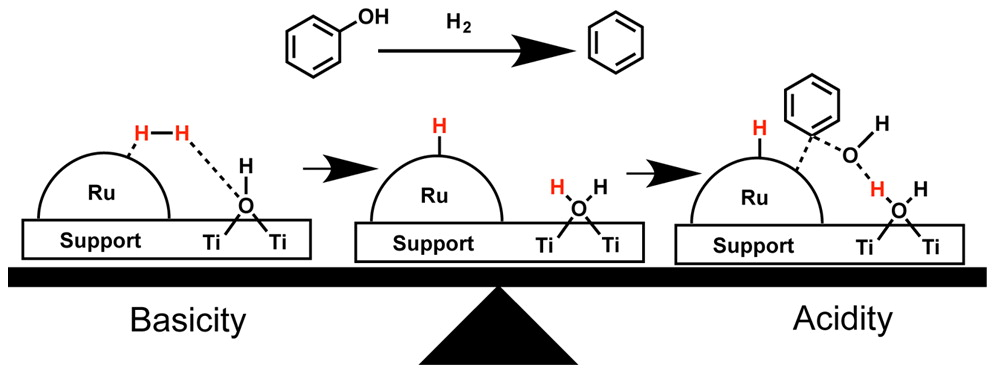Bio-oil upgrade to fuels and chemicals
Fast pyrolysis of biomass is a promising low-cost technology that produces bio-oil which can be upgraded to a transportation fuel or biochemicals. This upgrade requires reducing the high oxygen content (35 – 40 wt.%), which can be achieved through hydrodeoxygenation (HDO) over heterogeneous catalysts. The complexity of bio-oils with ca. 400 different oxygenated compounds, however, is attributed for the lack of fundamental understanding of this process. In contrast, hydrotreating reactors composed of cobalt and nickel promoted molybdenum sulfide based catalysts have been used for the removal of sulfur impurities for decades, and the fundamental principles governing this process are well understood.
In our group, we leverage the understanding and existing knowledge from the hydrodesulfurization (HDS) of petroleum derived feedstock for the design of novel catalysts for the upgrade of bio-oil. We have ample evidence to support our research hypothesis that HDO is similar to HDS at the atomic scale and can extract common features to develop unifying principles for catalyst design. This is enabled by extensive quantum chemical and kinetic Monte Carlo simulations.
Interfaces between metal nanoparticles and oxide supports have been identified as important catalytically active sites with bifunctional character for HDO of bio-oil. Our group has discovered that the interplay between metal sites and amphoteric supports, i.e. metal oxides that can behave both as acid and base, leads to high direct C-O scission selectivity during HDO. This discovery of a dual-site requirement for catalysis allows us to expand our search in discovering novel and cheap HDO catalysts. Similarly, we reported that synergistic effects in Pd/Cu alloys lead to increased selectivity during the Guerbet coupling reaction between alcohols. Ultimately, we aim to rationally design novel heterogeneous catalyst that enables the commercial use of biomass for the production of chemicals and fuels.
Related references:
- K. Goulas, S. Sreekumar, Y. Song, P. Kharidehal, G. Gunbas, P. Dietrich, G. Johnson, Y. Wang, A. Grippo, L. C. Grabow, A. Gokhale, D. F. Toste, “Synergistic Effects in Bimetallic Palladium-Copper Catalysts Improve Selectivity in Oxygenate Coupling Reactions”, J. Am. Chem. Soc. 138, 6805-6812 [DOI], 2016
- R. Nelson, B. Baek, P. Ruiz, B. Goundie, A. Brooks, M. C. Wheeler, B. G. Frederick, L. C. Grabow, R. Narehood Austin, “Experimental And Theoretical Insights Into The Hydrogen-Efficient Direct Hydrodeoxygenation Mechanism Of Phenol Over Ru/TiO2”, ACS Catal. 5, 6509–6523 [DOI], 2015
- J. Arce-Ramos, L. C. Grabow, B. Handy, M.-G. Cardenas-Galindo, “On the Nature of Acid Sites in t-ZrO2/SiO2 Mixed Oxide: A Combined Experimental and Periodic DFT Study”, J. Phys. Chem. C 119, 15150–15159 [DOI], 2015
